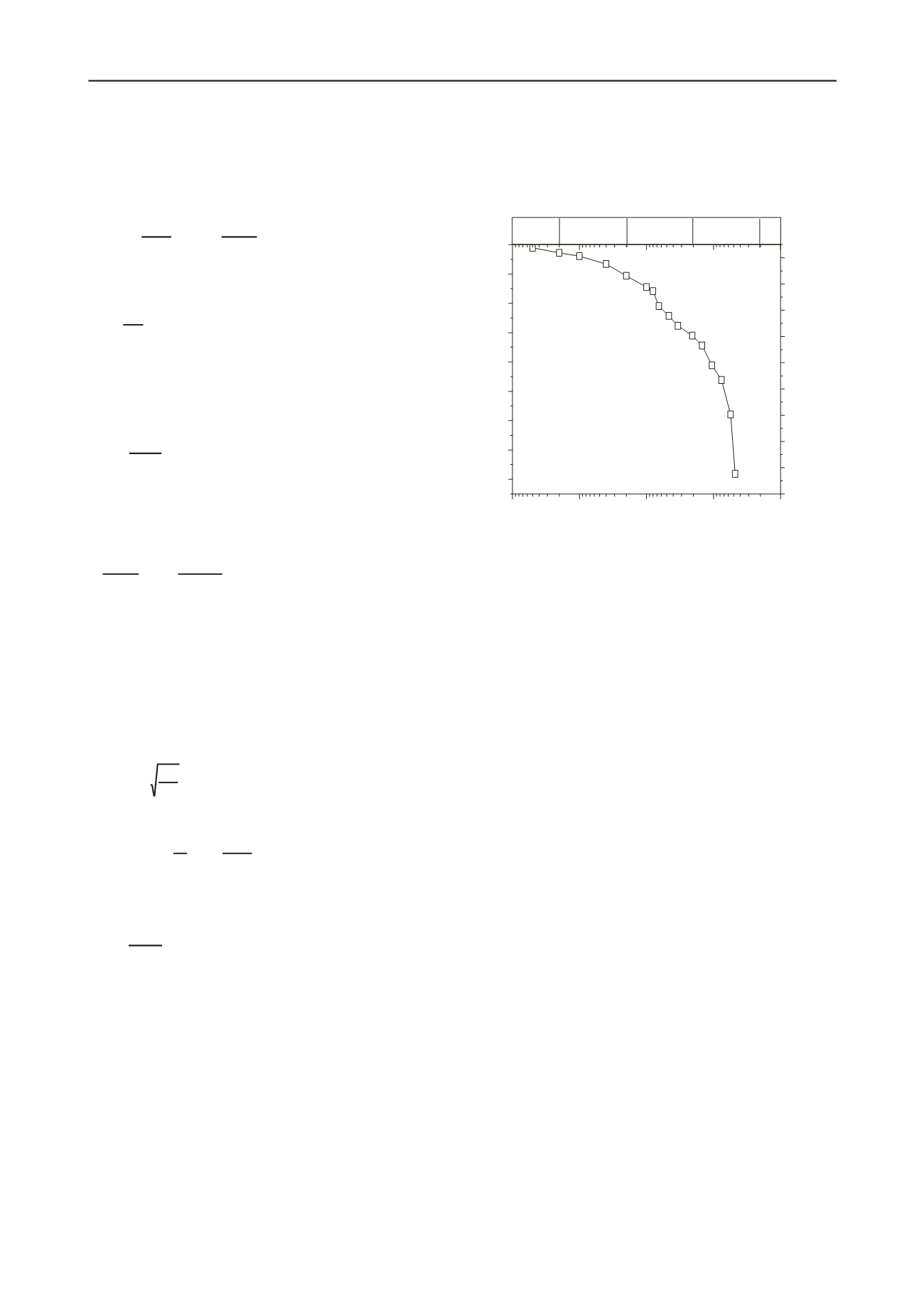
2510
Proceedings of the 18
th
International Conference on Soil Mechanics and Geotechnical Engineering, Paris 2013
Proceedings of the 18
th
International Conference on Soil Mechanics and Geotechnical Engineering, Paris 2013
2
10
1
0,1
0,01
1E-3
20
30
40
50
60
70
80
90
100
sieve's diameter (mm)
Percentage passing, (%)
Gravel
Fine sand
Silt
Clay
Coarse sand
The smear zone is defined as the remolded zone of soil
immediately adjacent to the drain.
F(n) is a Barron’s
function given by :
²n4
1 ²n3 n ln
1 ²n
²n nF
(4)
“n” is the drain spacing ratio given by:
w
d
D n
(5)
D and d
w
denote the equivalent diameters of unit cell and
of PVD, respectively.
T
r
is the dimensionless time factor of consolidation due to
radial drainage is written in function of time t:
²D
t C
T
r
r
(6)
.
For vertical consolidation problem, the differential
equation of one-dimensional consolidation for the excess
pore pressure is written (Terzaghi, 1943):
2
z 2
V
z
z
u
C
t
u
(7)
)u(
z
= Δu
(z, t) is the excess of pore pressure
depending of the depth z and time t;
C
v
is the coefficient of vertical consolidation.
Solution of the differential equation (7) is the vertical
degree of consolidation
v
U
as follows:
- U
v
< 50 %:
V
V
T
2 U
(8)
- U
v
> 50%:
4
² T
exp
²
8 1 U
V
V
(9)
(9)
T
v
denotes the time factor of vertical drainage:
²H
t
C
T
v
r
(10)
H is the drainage distance that is equal half of the
thickness of specimen.
2. STUDIED SOIL
Tunis soft soil specimens used in this study were obtained
from the Sejoumi
’s
lagoon at depth of 17.25 m. The
extracted sample is grey coloured, it has a characteristic
smell and contains shell debris. From grain size analysis
performed by hydrometer and sieving in accordance with
standards NFP 94-056 and NFP 94-057, (AFNOR, 1995),
it was found that Tunis soft soil presents 85 % of particles
with dimension less than 80 µm, it also includes a high
fraction of silt.
Figure 1. Gradation curve of Tunis soft soil
3. CONSOLIDATION TESTS
Three series of consolidation tests were carried out on the
Tunis soft soil in oedometer cells . These tests involved
applied increments of vertical load to the specimen and
measurements of the settlement. For each increment of
loading, the decrease of the thickness of the sample versus
time is recorded. Duration of the applied increment of load
depends on the soil and its consolidation characteristics.
The range of applied stress depends on the range of
effective stress which is needed in the consolidation
analysis of the studied. When the primary consolidation at
prescribed load level is completed (200 kPa) the sample is
unloaded in one or several steps until the increment of
load of 25 kPa is dismounted and the swelling of specimen
can be measured. The applied vertical load is doubled at
each increment until reaching the maximum required load
(50, 100, 200,400,800 kPa). The specimen is again
unloaded. At the end of the test, the sample is careful
removed and its thickness and water content are measured.
Series 1 (VD): It corresponds to a standard oedometer test
performed according to NF P94-90-1 standard (French
Standard, 1997). This test is carried out on a cylindrical
sample of saturated soil with 70 mm diameter and 19 mm
thickness. The soil sample is enclosed in a metal ring and
is placed on a porous stone. The loading cap has also a
porous stone, so the sample is sandwiched between two
porous stones at the top and bottom of the sample to allow
vertical drainage (VD).When preparing the sample, filter
papers are placed between the soil and the porous stones.
The sample is then placed in the consolidation cell and the
unit cell. Water is added into the cell around the sample,
so the sample remains saturated during the test.
Series 2 (RD): It corresponds to an oedometer test
performed on Tunis soft soil improved by a single
geodrain (Mebradrain 88) of sizes (thickness = 0.5 cm,
width = 1cm and length= 19 mm). In these tests only


